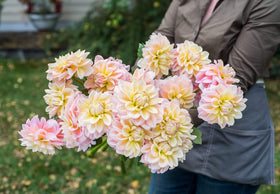Cosmos, a stunning flowering bloom (belonging to the daisy family) derives from the sunny and color-drenched climes of Mexico and Central America. Cosmos are beloved for a host of reasons, not the least of which are the colors they throw, and the ease with which they grow.
They are notable for their ability to tolerate heat, sun, and poor soil conditions. Cosmos are easy to propagate from seed. They have a long blooming period, lasting from mid-summer through fall. Cosmos are lovely in a cutting garden - never disappointing as they continue to *pop* - even as other flowers begin their seasonal retreat.
The floral diaspora of the Cosmos began when Spanish explorers introduced the bloom to Europe early in the 16th century. Later, Cosmos migrated to Africa and Asia. Horticulturalists can estimate that they were brought to North America sometime in the late 19th to early 20th century - where they became quickly popular as an ornamental flower. Because Cosmos are especially hearty, over the centuries these blooms have become native to many regions. (A native plant is one that has adapted to its surroundings, growing successfully in tandem with overall weather conditions to resist pests and other environmental challenges in relative terms.)
There are several species of Cosmos but the two most popular for growing from seed are:
Cosmos Bipinnatus – This variety, native to Mexico, also known as garden or wild cosmos, is the most common. Stems stand tall and proud - to deliver a bloom like that of a daisy in shades that range from pink and red to white and purple.
Cosmos Sulphureus – This variety, native to Mexico and Central America, also called the Sulphur Cosmos, blooms bright yellow or orange with petals reminiscent of daisies.

Planting and Caring for Cosmos
- We recommend that growers begin planning their Cosmos when they are certain that there will be no late frost. Once planted, Cosmos come up quickly – they are gratifying that way. Although these blooms tend not to attract pests, slugs are sometimes unwelcome visitors at first. Organic iron phosphate (Sluggo) can be a easy solution. Place seeds approximately 9 -12” apart and cover them with a light layer of soil.
- When stems are approximately 12” high, take the time (and don’t be afraid) to snip 3-4” of the plant just above a set of leaves. This signals the plant to send up multiple stems from below where the cut was made, resulting in more abundant flower production. (This practice also elongates the stems.)
- Cosmos do well, ideally, in slightly moist soil. They strongly dislike being waterlogged. For this reason, be mindful of drainage where one plants. As Cosmos mature, one should water less, not more. (Yes, even when conditions are dry – resist the understandable urge to overwater.)
- To extend the life of Cosmos, remember to deadhead. (To deadhead means to pluck the spent withered bloom on a stem to make way for a coming nascent bloom - ready to take the stage.) Removing spent heads before they set seed encourages continued blooming.
-
Harvest when the buds are colored but have not yet opened. This will extend their already long life.

Our personal picks:
At Bear Creek Farm, where we nurture beauty from the ground up, we have loved playing with:
Cosmos Apricotta: This variety grows to approximately 40” tall and displays luscious shades of pinks and apricot with a soft pink center.
Cosmos Apricot Lemonade: This variety grows large petals that begin with shades of soft apricot that give way to a subtle lavender base. Once mature, the blooms fall back into a pale yellow. Approximately 4” in diameter, they recall daisies.
Cosmos Cupcake Blush: This recently created variety grows petals that resemble, yes, a cupcake - largely fused as one - to resemble a poppy. This variety blooms in blush and white. Smaller and more delicate than its companion varieties, this cupcake Cosmos is, well, delectable.
Cosmos Double Click: This ruffled variety offers a mum-like strong stem – in two colors: shades of pink or violet.
Give yourself over to Cosmos and see what happens. They are kind friends – both generous and tenacious. They brighten the world in their unique and obliging manner – blooming where other flowers would surely fail. An ambassador flower, Cosmos make things easy - and that’s just nice too. (We’ll take it.)
Now that you've finished reading this article, you should check out our tulip planting primer, dahlia growing guide, and cutting guide for dahlias. And if you're shopping for dahlia tubers, make sure to check out our giant dahlia tubers (10"+ blooms), micro dahlia tubers (under 2" blooms), dark pink dahlia tubers, dark red dahlia tubers, and bicolor dahlia tubers.




